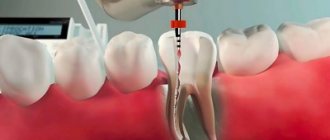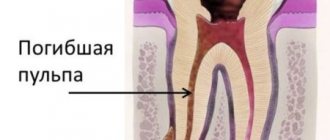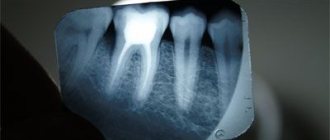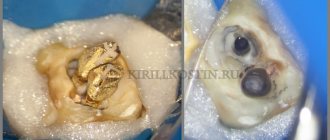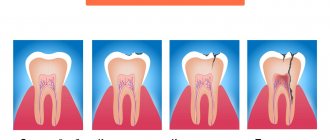What is three-channel pulpitis?
The number of canals in each tooth varies, usually one or two, in molars – most often three. There are record-breaking patients in whom up to eight processes were discovered during treatment. Three-channel pulpitis, as the name implies, is diagnosed in a tooth that has three channels. Inflammation of the pulp or, as is often said, the dental nerve, manifests itself in severe pain. It can be paroxysmal, worse at night, radiating to the ear or temple. It is impossible and dangerous to endure such acute pain for a long time. According to experts, pulpitis is the reason every fifth patient visits the clinic.
Indications for root canal treatment
The pulp is very sensitive to irritants and quickly becomes inflamed during infection.
Most often, the cause of its destruction is untimely cured caries. The deeper the carious cavity, the faster bacteria eat away dentin and cause irritation of the pulp. As soon as bacteria enter the internal cavity of the tooth, the person begins to feel pain. The problem cannot be solved on its own, since there is no way to remove bacteria from a closed cavity. And they quickly destroy the tooth itself and its nutritional system. The sooner you start treatment, the greater the chances of maintaining it.
There are a number of indications for treatment:
- acute or chronic stage of periodontitis;
- pulpitis;
- pain after treatment, indicating problems in the root canal;
- preparation for intracanal bleaching;
- preparation for prosthetics;
- vertical fracture of the tooth with subsequent damage to the pulp.
Specifics of treatment of three-channel pulpitis
Treatment of pulpitis of a 3-canal tooth is considered complex and must be carried out with special care. In severe cases, several visits to the dentist are required.
- The doctor spends an hour to an hour and a half on a multi-channel tooth;
- under a microscope - about two hours.
This is due to the fact that 3-channel pulpitis requires treatment in each process.
Treatment under a microscope
Treatment of three-channel pulpitis is carried out by a specialist in the field of endodontics. Work in the dental canals is best done under a dental microscope. This method has many advantages.
Advantages of treatment under magnification
- The dental canals are very thin, tortuous, no more than 1 mm in diameter. The microscope magnifies them to 2.5-3 cm. The dentist does not treat blindly, under magnification he clearly sees all the branches and foci of inflammation. Treatment of pulpitis of the 3rd canal takes place in good lighting.
- The patient lies down, the doctor looks not into the mouth, but into the microscope camera. This has a calming effect on dentophobes.
- The microscope reveals the most difficult to reach areas for the doctor. This is especially true for patients who have hidden dental canals that are not visible to the human eye. And during endodontic treatment, it is important to remove all foci of inflammation to avoid relapse.
What is periodontitis
Periodontitis is a dental pathology that involves the development of an inflammatory process in the tissues surrounding the tooth root. The more structures affected, the more difficult the treatment, since to obtain results it is necessary to identify and treat the root of each tooth. To carry out manipulations, a special microscope is required. This is especially true for two-, three-, and four-canal teeth, since the roots may be curved, or there may be extra growth in the root system that cannot be seen behind the remaining roots.
Periodontitis often occurs acutely and then becomes chronic. The acute form of the disease causes the sensation of an overgrown tooth, which is associated with an active increase in pressure. A common symptom is pain, which can become severe and aching. Sometimes there is swelling of the cheek or gums, as well as an increase in temperature.
The sooner you start treating the disease, the better. In chronic fibrous periodontitis, inflammatory processes may develop, accompanied by purulent discharge (sepsis, phlegmon).
Stages of treatment for 3-channel pulpitis
Treatment of pulpitis of one- and two-canal teeth, as a rule, occurs in one appointment. Three channels are put in order in two visits. Some clinics offer to treat pulpitis of the 3rd canal tooth in one go. There is no need to take risks, it is better to do everything according to the rules.
To treat three-channel pulpitis, the vital extirpation method is used. The pulp is removed, the canals are thoroughly cleaned, disinfected and sealed. Let's look at each stage of treatment of root pulpitis 3 in detail.
Stages of treating pulpitis without a microscope
- Pain relief using local anesthesia.
- Removing softened tissue and washing the cavity with an antiseptic.
- Expansion of the mouths of three canals and removal of pulp.
- Flushing the canals with sodium hypochlorite as an antimicrobial treatment.
- Drying and filling the canals and installing a temporary filling on the crown of the tooth.
- Evaluation of treatment results using control x-rays.
The main treatment takes place during the first appointment. A break is needed so that the filling material in the canals hardens well. The second stage will take less time: the tooth will be processed again and a permanent filling will be placed.
The number of appointments may increase to three if it is impossible to immediately remove the pulp from the canals. In this case, the nerve will be “killed” by a special paste. It will be added to the cavity and left until the next visit. Soviet patients said this: “They put arsenic.” This substance is not used in modern toothpastes, but many, out of habit, believe that the dental nerve is removed with the help of arsenic.
Treatment of a single-canal tooth
Root canal treatment for single-canal teeth involves cleaning the part where the nerve tissue was previously located. The purpose of this treatment is to eliminate bacteria accumulated in the inside of the tooth, remove all organic waste that is a breeding ground for bacteria and fill the vacated space, which completely stops their vital activity.
Single-channel teeth include incisors and canines. The exact number of channels is confirmed using a snapshot. The advantage of such teeth is that their canals are rarely branched or curved, which simplifies the treatment process and reduces the risk of possible complications.
Can three-channel pulpitis go away on its own?
Pulpitis of a three-canal tooth, of course, will not go away from lack of treatment and will become chronic. The nerve will die under the influence of microbes, the pain will go away, and the patient will deceptively think that the problem is solved. But this will turn out to be a temporary calm before the storm. The nerve will decompose inside the tooth, there will be even more microbes, inflammation will affect the surrounding tissues, and ultimately it will all end in the formation of a cyst. It will be very difficult to save such a tooth from removal. Treatment of pulpitis of a 3-canal tooth should be immediate.
Classification of pulpitis and its clinical manifestations
Any pulpitis is characterized by severe pain symptoms that occur during exposure to temperature and incessant pain at night.
| Type of pulpitis | Clinical manifestations |
| Acute focal | Painful symptoms of a paroxysmal nature with clear localization and long periods of calm. It occurs when exposed to temperature factors and is more pronounced at night. The dentist discovers a deep carious cavity. |
| Acute diffuse | Attacks of pain vary in duration and subside for a short period of time. At night they appear even more intensely than with focal lesions, and are especially strong when the patient assumes a horizontal position. |
| Chronic fibrotic | It is characterized by insignificant and short-lived pain attacks that occur under influences of various natures or due to the accumulation of exudate. When collecting anamnesis, the dentist identifies signs of acute pulpitis that the patient had previously. |
| Chronic gangrenous | The tooth begins to ache in the presence of thermal influences, and there is a putrid odor from the oral cavity. When collecting anamnesis, earlier attacks of acute pain are revealed, radiating along the trigeminal nerve. |
| Chronic hypertrophic | Patients note bleeding of the pulp tissue, which has grown, and pain symptoms that occur during meals. The crown part of the tooth is destroyed, and pulp tissue protrudes from the carious cavity, having undergone hypertrophic changes. |
The cost of treating pulpitis depends on its form and the severity of the process and is determined by the dentist after an examination.
How much will treatment cost in Moscow clinics?
Treatment of pulpitis of a three-channel tooth will cost the patient a lot. The price in Moscow dentistry starts from 5,000 (without a filling on the crown) - 7,000 rubles (with the simplest filling) and reaches 13,000 rubles. Treatment under a microscope increases the cost of 3-channel pulpitis to 21,000 rubles. The prices for treatment of pulpitis are influenced by the quality of the instruments used by the doctor, the choice of anesthesia, means for disinfecting the canals, as well as the material from which the filling is made. All this needs to be taken into account before going to the doctor.
Treatment methods for acute and chronic pulpitis
The main task of treating chronic and acute pulpitis is to restore the functionality of the tooth, therefore the main method of treatment is biological. It involves the use of pharmacological drugs, the action of which makes it possible to reverse the processes that have occurred in the pulp due to inflammation. Unfortunately, this approach is not always available: only in case of traumatic damage to the pulp or its accidental opening. If the processes are irreversible, doctors perform surgical treatment aimed at partial or complete removal of the pulp.
| Features of biological treatment | Features of surgical treatment |
| Treatment of chronic pulpitis is carried out using therapeutic pads impregnated with preparations containing calcium. They are applied to the area where the bone tissue is particularly thin and needs to be strengthened. After this, they perform a filling and observe how the tooth behaves further. This technique is indicated for pediatric patients with baby teeth, patients under thirty years of age, and all those who regularly and properly care for their oral cavity. If, after a course of treatment, the tooth continues to ache, and pain symptoms intensify at night, you need to seek professional dental help, since the pulp requires surgical treatment. | Surgical treatment of gangrenous and other types of pulpitis is carried out in two ways, and both are aimed at removing the pulp: partial and complete. If available, the dentist removes only the top portion of the nerve, preserving its functionality and ability to nourish the entire tooth. This treatment method is indicated for children whose teeth have not yet fully developed. Thanks to this, they continue to develop normally. If the pulp is completely affected, endodontic treatment is carried out aimed at removing it, cleaning the root canals and filling them. This method is quite complicated, especially when it comes to the treatment of three-channel pulpitis of the root tooth. It requires special skill and care from the dentist. |
Canal treatment using a microscope
The diameter of the root canal of a tooth is approximately 1 millimeter. In such conditions it is impossible to work with it without special optics. The dental microscope allows you to increase visibility up to 32 times. Therefore, it is increasingly used in modern dentistry.
Advantages of using a dental microscope:
- The specialist can see and remove only tissues affected by inflammation, without touching healthy ones.
- An excellent overview of the tubule orifices is achieved. Seeing the number of their branches, depth and directions is very important during endodontic treatment.
- Due to targeted treatment of the pulp, complications can be avoided. The possibility of perforations is also eliminated.
Tooth pulpitis: symptoms, treatment
All you have to do is ignore the resulting caries and not contact the dentist in a timely manner, and after a while you will have to go to the dental clinic urgently.
Symptoms of inflammation of dental tissues:
- sudden sharp, throbbing pain, significantly worsening at night and radiating to the neck, ear, and other areas of the face;
- pronounced reaction to any stimulus (temperature, mechanical);
- the appearance of putrid odor from the mouth;
- change in enamel color;
- temperature increase.
Timely treatment of pulpitis of permanent teeth allows you to preserve the neurovascular bundle, which is necessary for the normal functioning of dental units, so if you experience any discomfort, contact your dentist!
